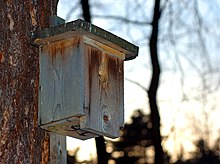Nest box
This article needs additional citations for verification. (November 2007) |

A nest box (or nestbox also called birdhouse) is a man-made box provided for animals to nest in. Nest boxes are most frequently utilized for wild and domesticated birds, but certain species of mammal may also use them.
Construction
Boxes are usually wooden, though some for birds are made from concrete or mixtures of wood and concrete, called woodcrete. Metal nest boxes are also marketed, but these are generally unsuitable for outdoor use, as they can overheat easily in sunshine.
The majority are cuboid, and many have a sloping roof. Many have a hinged top, side or front to provide access for cleaning, bird ringing or, when used for domesticated species, to give the breeder access to the young. Boxes may either have an entrance hole or be open-fronted. Some nest boxes can be highly decorated and complex. Designs mimicking human house design or other structures are common in some gardens.

Birds
Different sizes of nest-box suit different species of birds with very small boxes attracting wrens and treecreepers and very large ones attracting ducks and owls. The maintenance of nest-boxes to remove old nest material and any parasites is important if they are to be successfully re-used. Budgerigars and some other birds raised domestically will not usually mate unless a nest box is available.
Bats
Bat boxes differ from bird nest-boxes in having a (usually) much smaller opening, often on the underside of the box. Populations of many bat species are becoming threatened because of ecological pressures and the provision of appropriate bat-boxes can help support locally important populations. Bats are also becoming popular sources of natural mosquito and insect control in some parts of the world. A single bat can eat 500 to 1,000 mosquitoes a night[1] as well as numerous garden pests.[2] Directions for making the open bottom bat houses for small and large colonies,[3][4] as well as locations to purchase them are available on the internet.[5] Bat houses are an ecologically friendly way of controlling mosquitoes as pesticides mostly kill the mosquitoes' predators rather than mosquitoes.[4]
Other creatures
Nest boxes are marketed not only for birds and bats, but also for other mammals, especially arboreal ones such as squirrels and possums. Depending on the animal, these boxes are used for roosting, breeding, or both.
It should be noted that wasps may build their nests inside a nest box. People maintaining boxes should be duly prepared for this eventuality. Wasp nests are best removed during winter.

References
- ^ "Bats and Bat Houses" (Web). Mosquito Abatement District-Davis Headquarters, Kaysville, UT. Retrieved 2007-11-17.
- ^ McAvoy, Gene. "Hendry County Horticulture News: Bats Eat Mosquitoes as Well as Numerous Garden Pests" (web). UNIVERSITY OF FLORIDA; Cooperative Extension Service. Retrieved 2007-11-17.
- ^ "SINGLE CHAMBER BAT HOUSE (WALL MOUNTED)" (Web). Bat Conservation International. Retrieved 2007-11-17.
- ^ a b Brown, Carla. "Why I Built A Bat House" (Web). National Wildlife Federation. Retrieved 2007-11-17. Cite error: The named reference "Brown" was defined multiple times with different content (see the help page).
- ^ Boleky, Vaughan (2005–2006). "Why Are Bat Houses Important?" (Web). Organization for Bat Conservation. Retrieved 2007-11-17.
{{cite web}}: CS1 maint: date format (link)
External links
- Nest box page from the Royal Society for the Protection of Birds .
- Nest box plans: bluebirds, purple martins and others.
- How to build a nest box.
- Why watch bird nests?
- Bird Nest Box Safety Precautions
- Preparations before visiting nests
- Minimum bird nest box watches for good research criterias
